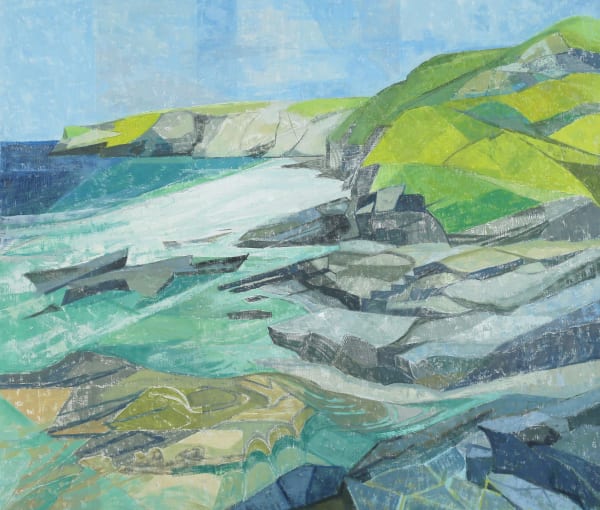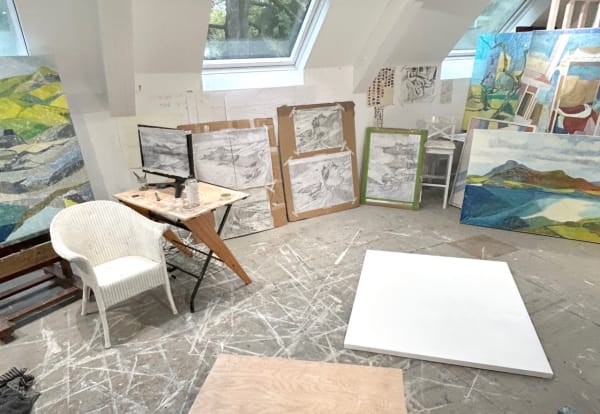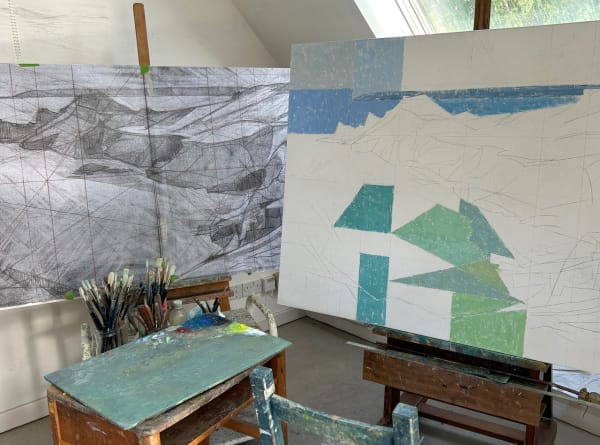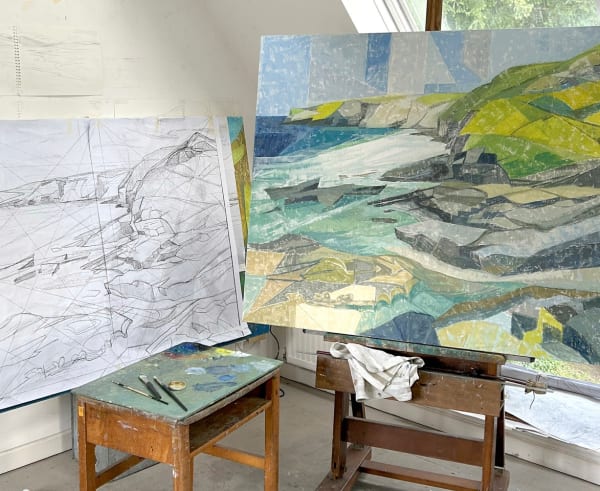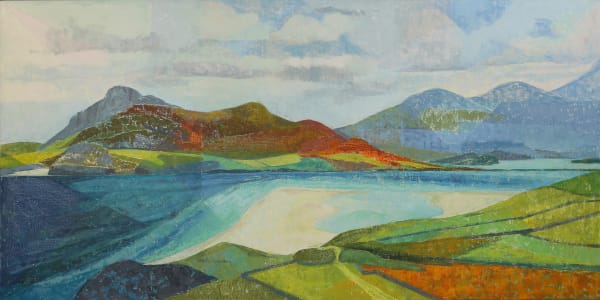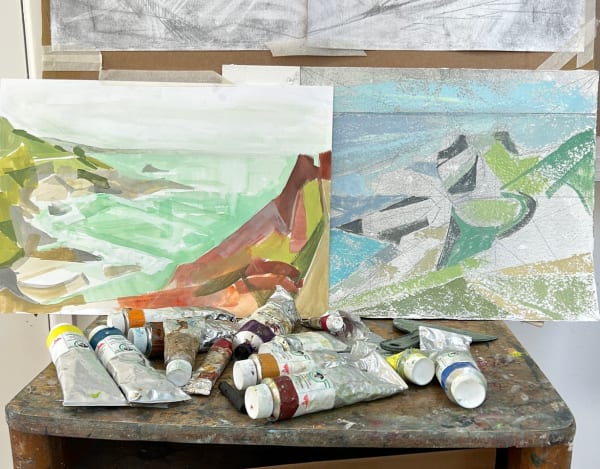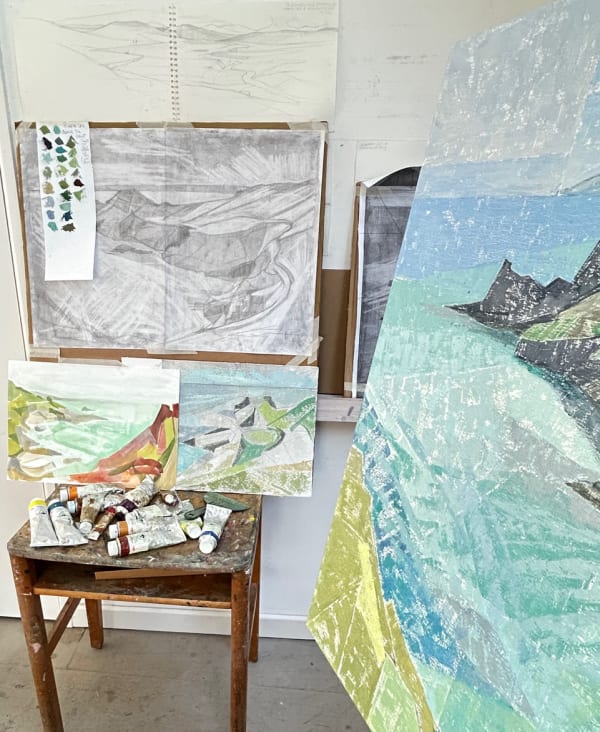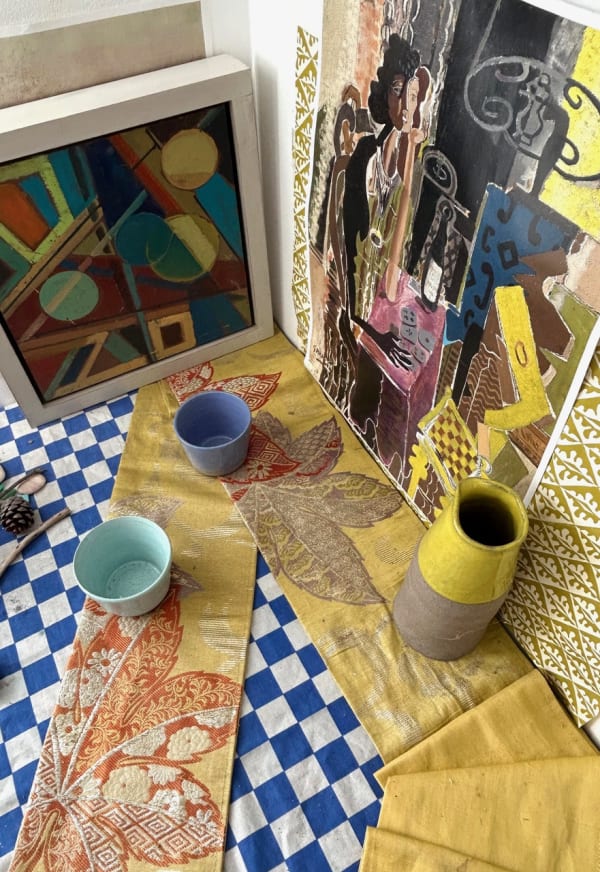Drawing is how I begin to understand what I’m looking at and is fundamental to making my paintings. I think of my work as a two-stage process: the empirical, observational part that takes place through drawing when I start to discover a new subject, and the synthetic compositional part that happens later on in the studio...
– Tessa Coleman, 2025
EASTWOOD FINE ART: You originally studied for a degree in Pure Mathematics, and this foundation appears to come through in your paintings, which bear an underlying structural sensibility. Has this had an impact on your work? How do you approach your compositions?
TC: You’re absolutely right on the structural sensibility underlying my paintings. My mathematical background definitely informs both my looking and my compositional process when making my paintings. Spatial and geometric organisation and pattern are deeply rooted with me. The more spatial and geometric relationships, rhymes and patterns I see in an image before starting to paint, the stronger the final work normally is.
I normally start a painting by drawing to work out the subject matter and point of view, and often, my large paintings are a visual collage of several different drawings. Considering the surface of the canvas in terms of proportions and divisions of the rectangle (the rabatment in technical painter language) helps me work out what goes where and gives me a starting point for the painting’s colour world. By the time I actually pick up my brushes and start painting, a lot of planning has already taken place, so I suppose my logical, mathematical, organising brain is also at work through the process of picture making. I look a lot at Italian fresco painting, and I use some of their technical processes like the use of cartoons to transfer drawings and very limited palettes in my own work.
EFA: Your subjects are wide-ranging, from close-up images of nature to sweeping views of the British countryside, cityscapes and portraits. How do you choose your subject matter?
TC: Some painters manage to think directly in paint, but drawing is how I begin to understand what I’m looking at and is fundamental to making my paintings. I think of my work as a two-stage process: the empirical, observational part that takes place through drawing when I start to discover a new subject, and the synthetic compositional part that happens later on in the studio, armed with my paint brush, often stitching together different drawing elements. Finding the subject matter is all about spotting interesting colour combinations, patterns, rhythms and structure, whatever the set-up is and seeing where you can go with it.
In terms of what I paint, the subject matter itself feels less important than what I do with it, which depends on all sorts of variables, including my mood, the weather, and how ambitious I am feeling. This determines whether I decide to tackle something from life in the studio or venture out into the world and investigate. I then make a larger painting from several drawings back at home. My work has always been a synthesis of the directly observed and imagined worlds. I find both types of work important, and each feeds off the other. Small-scale direct observational work flexes slightly different visual muscles and helps to build the stamina needed for the larger-scale, more invented work.
EFA: Alongside your work, you teach at The Royal Drawing School. Has teaching impacted your practice?
TC: Definitely! Explaining ideas to students is a marvellous way of clarifying my own practice and ideas, and being challenged by curious students is a great way to mix things up a little back in the studio. For example, I did a course recently on shadows in painting, which was so much fun. Thinking about where and when shadows appear in Art History, the technical and emotional aspects of shadows and how they are made, but also what they tell you about the underlying philosophy of the painter’s world. These conversations with students led to new visual ideas both in the work that they made and also in my own work back in the studio later on.
Like most artists, I’m constantly looking at other people’s work, noting down and borrowing motifs, colour palettes, and compositional structure. Teaching is also a great way of re-considering and sharing this library of visual references that I’ve collected over the years.
EFA: Have any recent experiences given you a new perspective/inspiration for your day-to-day work?
TC: Too many to count, but one that stands out from the last few weeks is the show Siena: The Rise of Painting, 1300 ‒1350 on at the National Gallery in London at the moment. I was lucky enough to see it in New York twice earlier this year and will visit a few more times, I’m sure. It really is marvellous! It concentrates on four of my favourite painters: Duccio, the Lorenzetti Brothers and Simone Martini over five decades. I thought I knew their work pretty well, but this exhibition highlights new aspects of their inventiveness and compositional strengths, which are very exciting.
In particular, the curators have been very good at juxtaposing the paintings with Sienese objects such as sculpture, textiles and reliquaries that encourage one to consider the paintings being shown as beautiful hybrid three-dimensional objects and not simply as images, and I’d like to think about this idea more in my own work. For example, in several of the exhibition’s paintings, the frame is both an integral part of the image and border simultaneously, and sometimes the image bursts out into the frame. There are also several small portable altarpieces; one in particular is the Orsini altarpiece by Simone Martini, where six small narrative pictures are hinged together in a beautiful folding book arrangement that can be opened up in several different ways depending on which part of the narrative you want to look at.
The other aspect of early Sienese painting that I love is the poetic space making that is so much more than linear perspective: how the whole world can be contained in a miniature panel, for example in Duccio’s aerial views of seven cities in his predella panel The Temptation of Christ, and I want to explore this inventive space making more in my own landscape work back in the studio. When I was doing my Masters in New York at the New York Academy of Art, I wrote my dissertation on different ways of making space in painting and I’d like to return to some of these ideas again in the future.
EFA: Is there anything you cannot be without in your studio?
TC: Absolutely, quite a few things. I’ll give you one practical thing and one talisman if you like. The practical thing that I always have in my studio is a newspaper. I tend to paint quite thick, often with a palette knife, and newspaper is the best way to speed up drying so that I can continue to paint through a process called tonking. Essentially, you press newspaper onto the wet paint on the canvas and it soaks up the excess oil, like blotting paper, so that your painting dries faster and you can carry on painting without having to wait days for the underlayer to dry. The technique is named after its inventor, Henry Tonks, Professor of Fine Art at the Slade in the early twentieth century.
The talisman is the first art book I ever looked at: it is a 1920s catalogue of the Uffizi Collection that my grandmother was given when she was young. It is so old that the colour images are postcards that have been stuck into the book and are very faded now. It entranced me as a young child and got me hooked on early Italian painting, which is still my go-to, happy time and place for artistic inspiration. I find the simplicity, clarity and crispness of their colour relationships totally beautiful.
EFA: For SPOTLIGHT, you are showing two new paintings. Tell us more about them!
TC: Both of these works are large landscape paintings made in places I know well and have visited many times over the course of years. They are made from drawings done out in all weathers and collaged together back in the studio.
As its name suggests Above Trebarwith Strand was made from drawings high up on the cliff above Trebarwith Beach in Cornwall and my aim with this painting in particular was to portray more than the merely visual, to capture the feeling of precariousness brought on by the plunging away of the cliff down to the swirl of sea and rock below.
My viewpoint in Skinnet Beach, Kyle of Tongue up on the North Coast of Scotland was less precarious, but both painting are all about edges, the interaction of land and sea and how they shape each other over eons. In Trebarwith Strand the big waves roll in and pound away relentlessly at the cliff edge, whilst in Skinnet Beach the interaction of land and sea is far more gentle and subtle and subject also to the flow of the Kinloch River flowing off Ben Hope and Ben Loyal mountains into the south end of the Kyle or channel. I have tried to capture and accentuate those different forces in the shapes and colours that I’ve seen both in the lay of the land in the far distance and in the close-up rock pools and sand bars in both paintings.
